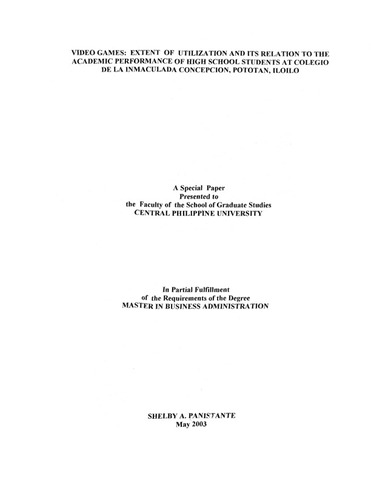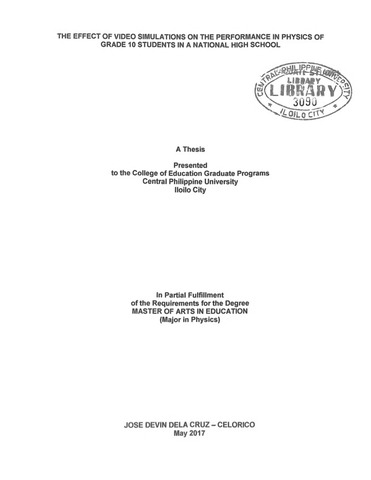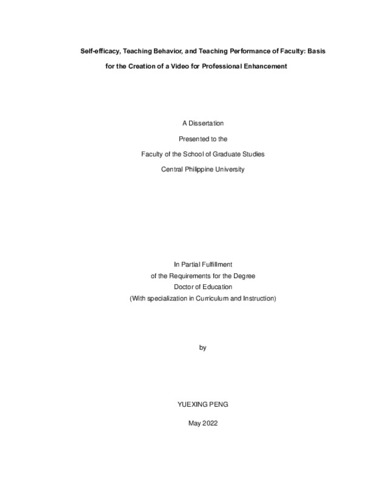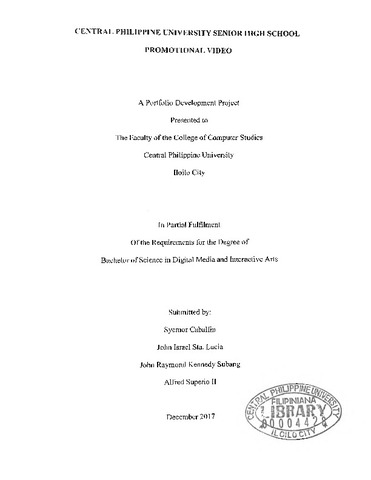| dc.description.abstract | Background and Rationale of the Study
Video games were first introduced in the 1970’s. By the end of that decade they had become a preferred childhood leisure activity, and adults responded with concern about the possible ill effects of the games on children. Early research on these effects was inconclusive. However, after the introduction of the Nintendo system, resurgence in video game sales in the late 1980’s has renewed interest in examining the effects of video games.
Playing video games may affect some children’s academic performance. The amount of time playing video games, has a negative impact on school performance, by many different measures. Studies by Buchman and Funk show than teens who play more each week, and have played more over their lifetime, perform more poorly in school that teens who play less. Like watching television, playing video games displaces other activities of children, such as reading, playing outside, exercising or participating in sports, working on hobbies such as music or art activities, doing homework, or simply talking with friends and family.
Homework and chores are the activities, most likely to be displaced by game playing., according to twenty one percent of teens surveyed in a study from British Columbia. The study revealed that teenagers who played video games more than seven hours a week were most likely to play games instead of participating in other activities; thirty seven percent (37 percent) these heavy players said they played at the expenses of homework and chores, and eighteen percent (18 percent) said they gave up family activities.
Douglas Gentile, Ph.D., Director of Research at the National Institute on Media and Family in collaboration with Paul Lynch of the University of Oklahoma, conducted a study to determine the effects of video and computer games on children and teens. A survey was administered to 137 teens in grades 8-12 in a large suburban school district near a large Midwestern city. Ninety four (94) were students in general classes and (43) were students in a special program for “risk students.” The study showed that 25 percent of the teens (41 percent of boys) said that they have played so much that it interfered with their homework, 13 percent (21 percent of boys) say they have done poorly on a school assignment or test, because they spent too much time playing video games, 89 percent of teens (91 percent of boys) said that their parents “never” put limits on how much time they are allowed to play video games.
Then Henry S. Kaiser Family Foundation (1999), which has extensively studied children’s use of all forms of media, found that children who earned lower academic grades spent about one hour more a day, exposed to media that their counterparts with higher grades did. The study however did not evaluate what caused the lower grades, and both group of students spent about the same amount of time on video games.
A study by Roberts showed that playing video and computer games peaks between the ages of eight and thirteen . A study at the National Institute on Media and the Family found a similar pattern with game playing time peaking between eight and fifteen (Gentile and Walsh, 1999). A study by Lin S. Lepper MR (1987) of 234 fourth- through sixth grade students also revealed that a small but significant negative relationship exists between arcade game use and teachers’ ratings of math ability and general academic ability in boys. No such relationship however was found when games were played at home.
A similar study was conducted by Merruel G. Tuvida (March 1998) of Iloilo National High School “Perceived Effects of Computer Games To the Academic Performance of Special Science Class Students.” The subjects of the study were the 156 out of 256 students of the special science class of Iloilo National High School. The findings revealed no significant effect of computer games on student’s academic performance. The reason is obvious—since students of the special science class are chosen and proved to be more intelligent than those who belonged in the regular classes. Thus, more exposure on video or computer games is considered an enhancement of students learning skills, inquisitiveness, and creativity. The conflicting results of studies on the effect of computer games on school performance suggest the need for further research on the subject. One of the question that need to be addressed is: Does video game really affect the students’ performance in school?
Conclusions
In view of the findings, the following conclusions were drawn:
1. The finding that video games extent of utilization affect the academic performance of the students seemed to indicate that the students were enticed into playing video games leisurely so as to effect their study habits. Jennings (1985) states that computer or video games are hard to regulate, their very nature resist the imposition of time limit. Every player wanted to finish certain game once they started just to satisfy themselves but if they cannot, the players will pursue to finish it. McLennan (1983) adds that computer games will harm the academic performance of the students if they were abused. The results in this study however negates one of the advanced hypotheses which states that “ Students who play video games less than three hours a day perform well in school”, as the study revealed that out 58 respondents who played video games less than 1 hour a day, 17 respondents or 29.31 percent got an above satisfactory grade of 86 to 90 percent, the 20 respondents or 34.48 percent obtained the satisfactory grade only of 81 to 85 percent, then the other 20 respondents or 34.48 percent obtained below satisfactory grade of 75 to 80 percent, and only 1 respondent or almost 2 percent (1.72 percent) got an outstanding grade of above 90 percent, while out of the 4 respondents who played 3 hours or more, 7 respondents or 50 percent got a satisfactory grade of 81 to 85 percent, a little more than a quarter percent (28.57 percent) got an above satisfactory grade of 86 to 90 percent and a little less than a quarter percent (21.43 percent) has below satisfactory grade of 75 to 80 percent. Thus, in this study the number of hours spent daily in playing video games cannot be truly inferred a varying factor in the academic performance of respondents. Regardless of the number of hours spent by respondents in playing video games, majority still obtained only a satisfactory grade of 81 to 85 percent.
2. The findings that slight differences existed in the relation of video games extent of utilization in the academic performance of students classified as to gender and place of residence seemed to indicate that male and female, and those residing either in urban or in the rural areas were homogenous in their perception regarding school and recreational activities.
3. As revealed by the present study, the first year students showed a significantly varying results in their academic performance. This supports the claim of Sutton-Smith (1986) that young children can manipulate video games more quickly than older children, suggesting that too many pre-existing ideas and strategies, yet do not completely obstruct their perceptual alertness, study habits and academic performance.
Moreover, the study also did not revealed that students receiving a higher daily allowance spent more time and money in video games and perform poorly in school. This is perhaps due to the result of the strict observance and implementation of the school policy in Colegio de la Inmaculada Concepcion prohibiting students’ to leave or get out the school premises during class hours.
Implications
The findings of the present investigation have led to certain implications for theory and practice in relation to the extent of utilization of video games in the academic performance of CIC students.
For theory. The finding of the present study revealed that video games extent of utilization had a considerable relation and effect to CIC students academic performance.
This finding supports McLennann’s (1983) theory that computer and video games could weaken the academic performance of the students. This is connected to the motion of Jennings (1985) video and computer games are very hard to regulate, only range of the game and the time limit could stop it.
The study also revealed that first year students extent of utilization of video games showed a significant varying differences to their academic performance. The finding supports the claim of Sutton-Smith (1986) that young children seem to be able to learn how to play computer and video games much more easily and quickly than the older students’ because their perceptual alertness was not yet disturbed by too may existing ideas and phenomenon.
The finding also that the academic performance of female respondents belonging to the Star Sections in the First Year and Fourth Year level were not affected by their extent utilization of video games supports what some experts say that when used wisely, video and computer games could sharpen students’ memories and improve their abilities. The finding of this study too, further supports the study conducted by Merruel G. Tuvida (March 1998) that there was no significant difference in the effect of computer games to INH Special Science Class, them being more intelligent as compared to those students’ belonging to regular classes, and that more exposure on computer games is more of an enhancement of students’ learning skills, inquisitiveness and creativity.
For practice. The findings can certainly be instrumental in the clearer understanding of the relation of the extent of utilization of video games to the academic performance of CIC students.
The study revealed that computer and video games had an effect to the students’ academic performance, indicating that very few of the students are not fond of playing video games. That a big number are playing these games, decreasing now some of their time spent in studying their lessons in school. Thus, majority only obtained a satisfactory grade, rather than an above satisfactory or outstanding grade.
Schools and most parents now, tried to provide their students and children with computers to help them in their studies. However, these computers have games that are always tempting the students and children to play. Both the schools and parents tried to stop and regulate this but because of the fact that computer and video games are hard to regulate, students do their best to satisfy their needs of these games. Some spent and stay in computer and video game houses and arcades, and at times missed their classes.
Computer and video games may improve a child’s hand-eye coordination, physical skills, decision making, ability to make friends and creative imagination. This is what majority of the students’ reason out why they play video games. Not fully understanding that these games will consume their study time and harmed their academic performance.
Some students considered computer and video games as friends because these games actually helped them increase their academic performance. They play video and computer games wisely . By these strategic way, these students’ were able to survive the negative effect of video games.
Finally, the academic performance of the students when classified according to gender got an apparent and varying significant difference. This is because, video games remain to be a generally popular game amongst the male population, and that the advanced hypothesis that males play video games more than females is confirmed and revealed to be true in the results of this study.
Recommendations
Based from the findings and conclusions, the following recommendations are hereby presented:
1. The relation of video games extent of utilization to the academic performance is relevant to the education of the CIC students since some cases sho wed that video games could harm the academic performance of a big number of students of the CIC. The school then, should inform their students more about video games and its extent of utilization in relation to their academic performance.
2. The teachers and parents should consider and determine the extent of utilization of video games by their students and children so that they could help them develop and improve their present academic performance.
3. Furthermore, studies along this line should be conducted taking into consideration the subjects taught in the school of respondents. Related studies are also recommended to public or college students as respondents. | en_US |





